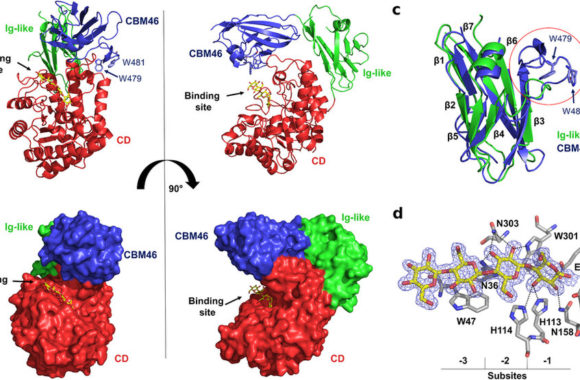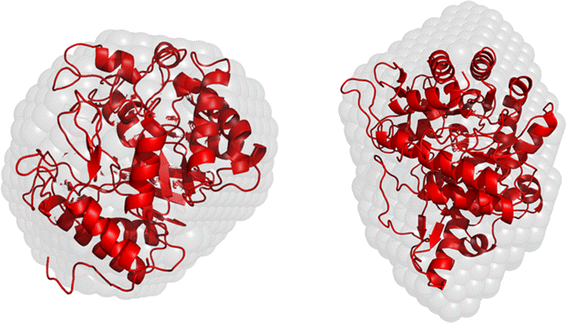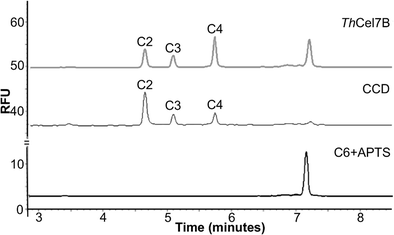O Grupo de Biotecnologia Molecular do IFSC/USP procura candidatos para bolsas de Doutorado Direto, Doutorado e Mestrado, interessados em desenvolver trabalhos nas áreas de Biologia Estrutural, Biotecnologia Molecular e Biofísica. Há oportunidades em dois projetos do grupo. O primeiro projeto visa compreender as bases moleculares da hidrólise enzimática de polissacarídeos de parede celular de […]

Molecular characterization of a family 5 glycoside hydrolase suggests an induced-fit enzymatic mechanism.
Abstract Glycoside hydrolases (GHs) play fundamental roles in the decomposition of lignocellulosic biomaterials. Here, we report the full-length structure of a cellulase from Bacillus licheniformis (BlCel5B), a member of the GH5 subfamily 4 that is entirely dependent on its two ancillary modules (Ig-like module and CBM46) for catalytic activity. Using X-ray crystallography, small-angle X-ray scattering […]

Biochemical Characterization and Low-Resolution SAXS Molecular Envelope of GH1 β-Glycosidase from Saccharophagus degradans.
The marine bacteria Saccharophagus degradans (also known as Microbulbifer degradans), are rod-shaped and gram-negative motile γ-proteobacteria, capable of both degrading a variety of complex polysaccharides and fermenting monosaccharides into ethanol. In order to obtain insights into structure-function relationships of the enzymes, involved in these biochemical processes, we characterized a S. degradans β-glycosidase from glycoside hydrolase […]

Recombinant Trichoderma harzianum endoglucanase I (Cel7B) is a highly acidic and promiscuous carbohydrate-active enzyme
Trichoderma filamentous fungi have been investigated due to their ability to secrete cellulases which find various biotechnological applications such as biomass hydrolysis and cellulosic ethanol production. Previous studies demonstrated that Trichoderma harzianum IOC-3844 has a high degree of cellulolytic activity and potential for biomass hydrolysis. However, enzymatic, biochemical, and structural studies of cellulases from T. […]
HTP-OligoDesigner: An Online Primer Design Tool for High-Throughput Gene Cloning and Site-Directed Mutagenesis
Following burgeoning genomic and transcriptomic sequencing data, biochemical and molecular biology groups worldwide are implementing high-throughput cloning and mutagenesis facilities in order to obtain a large number of soluble proteins for structural and functional characterization. Since manual primer design can be a time-consuming and error-generating step, particularly when working with hundreds of targets, the automation […]

Programming: Pick up Python
A powerful programming language with huge community support. Article in Nature. Nature 518, 125–126 (05 February 2015) doi:10.1038/518125a
Nuclear receptor full-length architectures: confronting myth and illusion with high resolution
The crystal structures of three nuclear receptor (NR) complexes have emerged to reveal their multidomain architectures on DNA. These pictures provide unprecedented views of interfacial couplings between the DNA-binding domains (DBDs) and ligand-binding domains (LBDs). The detailed pictures contrast with previous interpretations of low-resolution electron microscopy (EM) and small angle X-ray scattering (SAXS) data, which […]
RXR agonist modulates TR: corepressor dissociation upon 9-cis retinoic acid treatment
Transcriptional regulation controlled by thyroid hormone receptor (TR) drives events such as development, differentiation and metabolism. TRs may act either as homodimers, or as heterodimers with retinoid X receptor (RXR). Thyroid hormone T3 (3, 3`,5 triiodo-L-thyronine) preferentially binds TR:RXR heterodimers, which activate transcription through coactivator recruitment. However, it is unclear if TR:RXR heterodimers may also […]
High-throughput cloning, expression and purification of glycoside hydrolases using Ligation-Independent Cloning (LIC).
Recent advances in DNA sequencing techniques have led to an explosion in the amount of available genome sequencing data and this provided an inexhaustible source of uncharacterized glycoside hydrolases (GH) to be studied both structurally and enzymatically. Ligation-Independent Cloning (LIC), an interesting alternative to traditional, restriction enzyme-based cloning, and commercial recombinatorial cloning, was adopted and […]
Family 1 carbohydrate binding-modules enhance saccharification rates.
Cellulose degrading enzymes usually have a two-domain structure consisting of a catalytic domain and a non-catalytic carbohydrate-binding module. Although it is well known the importance of those modules in cell wall degrading process, their function is not yet fully understood. Here, we analyze the cellulose-hydrolysis activity enhancement promoted by the cellobiohydrolase I carbohydrate-binding module from […]